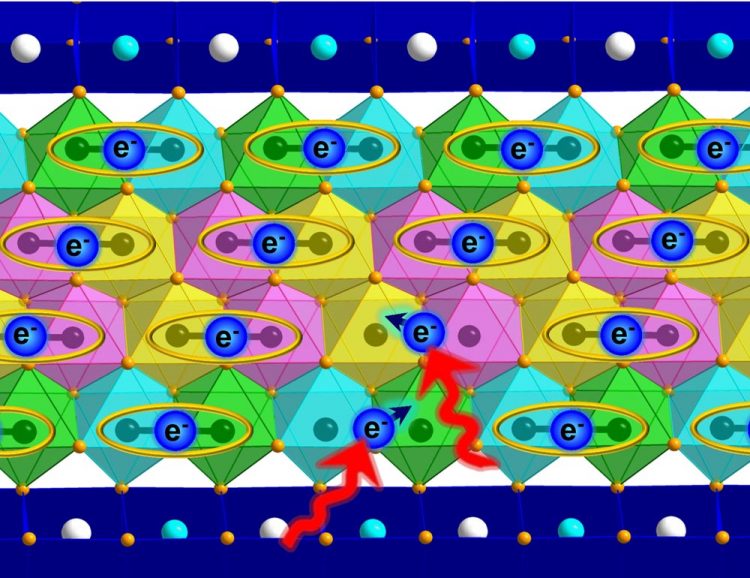High-pressure scientists in Bayreuth discover promising material for information technology

Schematic representation of the iron oxide Fe₅O₆ after the transition to the new crystal structure at minus two degrees. Two iron ions each share one electron, thus forming a pair. With light beams (red) these ions can be processed in such a way that this bond is loosened and the atomic distance between them increases. Image: Sergey V. Ovsyannikov.
The material is an unusual form of iron oxide with the formula Fe₅O₆. The researchers produced it at a pressure of 15 gigapascals in a high-pressure laboratory of the Bavarian Research Institute of Experimental Geochemistry & Geophysics (BGI) based at the University of Bayreuth.
If the temperature drops to two degrees Celsius, as can be found in a household refrigerator set rather cold, a sudden structural change occurs: Iron ions, which are strung together in long chains at higher temperatures, rearrange themselves into pairs instead. Two iron ions form a bond between each other, which consists of a single shared electron only.
Applying light rays selectively from an external source can intervene in the formation of this new crystal structure. If they have a suitable wavelength, they are able to break the bond between two particular iron ions: the ion pair splits up.
As a result, the individual iron ions begin to move around somewhat, meaning their distance from each other and their physical state change. “This targeted influencing of atomic spacing at refrigerator temperatures, which are easy to achieve industrially, has great potential for application in the IT sector.
It can be used, for example, in quantum computers, for storage elements measuring only a few nanometers, or for equally tiny switches,” explains Dr. Sergey Ovsyannikov from BGI, first author of the publication.
The synthesis and investigation of iron oxide Fe₅O₆ are of fundamental importance in clarifying the relationships between the crystal structure of iron oxides and their physical properties. This is a further finding of the study now published.
Interestingly, the distance between the iron ions, which are strung together in chains at normal ambient temperatures, seems to determine at exactly which lower temperature the aforementioned sudden structural change occurs, and the resulting new properties arise.
“These findings provide a valuable basis for developing new materials for information technology”, resumes Prof. Dr. Leonid Dubrovinsky from BGI, who coordinated the research work.
Background:
The significant structural change that researchers have now discovered in iron oxide Fe₅O₆ is known in physics as the “Verwey charge-order transition”. Until now, such a temperature-dependent transition, which is accompanied by a change in electronic and other properties, had only been well-studied in iron oxide Fe₃O₄. In this material, however, the changes only occur when the temperature drops to minus 153 degrees Celsius. At this transition temperature, any applications for information technology would be difficult to implement.
Image for download:
https://www.uni-bayreuth.de/en/university/press/press-releases/2020/028-New-IT-M…
Prof. Dr. Leonid Dubrovinsky
Bavarian Research Institute of Experimental Geochemistry & Geophysics (BGI)
University of Bayreuth
Telephone: +49 (0)921 / 55-3736 or -3707
E-Mail: Leonid.Dubrovinsky@uni-bayreuth.de
Sergey V. Ovsyannikov et al.: A Room‐Temperature Verwey‐type Transition in Iron Oxide, Fe₅O₆. Angewandte Chemie – International Edition (2020). URL: http://dx.doi.org/10.1002/anie.201914988
Media Contact
More Information:
http://www.uni-bayreuth.de/All latest news from the category: Information Technology
Here you can find a summary of innovations in the fields of information and data processing and up-to-date developments on IT equipment and hardware.
This area covers topics such as IT services, IT architectures, IT management and telecommunications.
Newest articles

NASA: Mystery of life’s handedness deepens
The mystery of why life uses molecules with specific orientations has deepened with a NASA-funded discovery that RNA — a key molecule thought to have potentially held the instructions for…

What are the effects of historic lithium mining on water quality?
Study reveals low levels of common contaminants but high levels of other elements in waters associated with an abandoned lithium mine. Lithium ore and mining waste from a historic lithium…

Quantum-inspired design boosts efficiency of heat-to-electricity conversion
Rice engineers take unconventional route to improving thermophotovoltaic systems. Researchers at Rice University have found a new way to improve a key element of thermophotovoltaic (TPV) systems, which convert heat…



